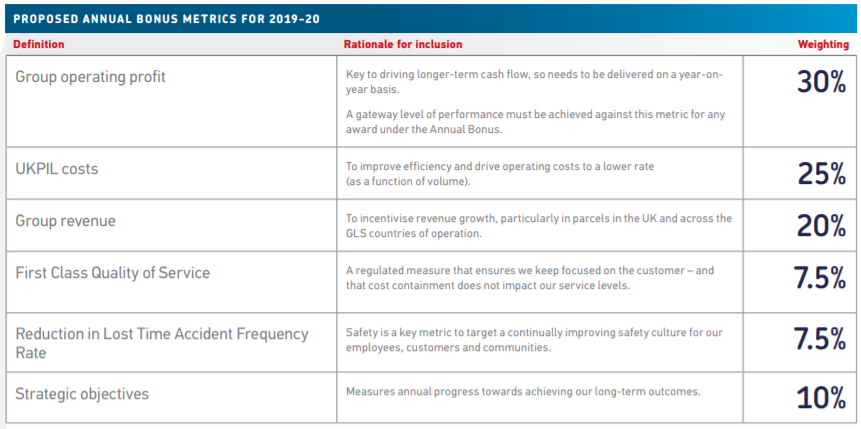As described in our accompanying article on sustainability incentivisation, a growing number of companies are linking executive pay to sustainability metrics. These are most commonly included in annual bonus/short-term incentive plans (STIPs), but are increasingly also reflected in long-term incentive plans (LTIPs) – defining not just cash pay but share awards too.
Below are some examples of different companies’ approaches. One common theme should be noted – the majority of the examples are European. Companies in other regions have been slower to respond to this growing trend. As our main article highlighted, according to ISS, fewer than 5% of S&P 500 companies include ESG metrics in STIPs, and fewer than 1% include them in LTIPs. And while Deloitte found that 28% of compensation-related shareholder proposals in the US last year concerned linking pay to ESG, none attracted sufficient votes to pass.
Royal Mail is one example of a company that includes employee- and customer-focused metrics in its STIP. In 2019, the company proposed a simplified bonus structure, based on 75% financial and 25% non-financial metrics (see below). This replaced a more complex structure, which had included three different safety metrics, an employee engagement score, a customer satisfaction score, and three measures of service quality and productivity. However, its LTIP remains based purely on financial metrics.

Intel is a rarer example of a US-based company aligning its short-term incentives with ESG metrics. While the overview shown below states that 50% of the annual bonus is based on unspecified “operational goals”, the company this year responded to investor requests that it further disclose the ESG metrics included in the plan. These include metrics related to diversity, inclusion, employee experience and, as of 2020, climate change and water stewardship.

Danone links both its STIP and LTIP to ESG factors. Its annual variable compensation is weighted over three elements – economic (60%); social, societal and environmental (20%); and managerial (20%). In 2020, the social, societal and environmental portion was awarded based on strong employee sustainability engagement results, Danone’s 1.5° climate commitment and continued strong results on the CDP Climate survey.

Meanwhile, since 2018, Danone’s long-term shares compensation plan (payable to the chairman, CEO and about 1,600 managers) has also included an environmental portion, weighted 20%. This is based on CDP performance, with 100% awarded if Danone receives an “A” rating for three consecutive years.
Shell has included “sustainable development” metrics in its STIP for a number of years, including safety performance and upstream/direct GHG performance. In 2019, Shell responded to pressure from activist shareholders by including an “energy transition” metric in its LTIP (weighted 10%). The metric is based on a “mix of leading and lagging measures”: reduction in Shell’s net carbon footprint (a new carbon intensity measure that includes customer emissions), as well as growth in Shell’s power, biofuels and carbon capture efforts (see below).

In December 2019, Siemens announced an overhaul of its long-term Stock Award for the top executives who sit on its managing board. This included a new “sustainability index”, based on three equally weighted metrics: “reduction of CO2 emissions, the number of training hours per employee – in particular due to the challenges posed by digitalization – and the Net Promoter Score for measuring customer satisfaction”.

Unilever is another example of a company that has created a composite “index” measure of sustainability in its LTIP, known as its “Sustainability Progress Index”, with a 25% weighting. Following the introduction of the index in 2017, Unilever faced pushback from investors, who wanted more transparency in how the index was calculated. The board subsequently agreed to publish an annual progress report, capturing the assessment of its Corporate Responsibility and Compensation Committees (see below) on performance against key elements of the Unilever Sustainable Living Plan, as well as external ratings.

For further reading, see our accompanying article on sustainability incentivisation.
Charlie Hodkinson-Ashford, Senior Consultant, NA


